"Together, We Do Have the Power to Do Wonderful Things"
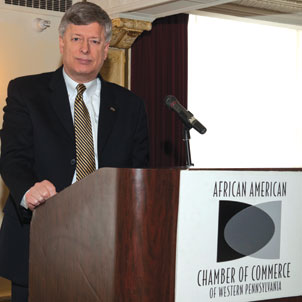 Mark A. Nordenberg
Mark A. NordenbergThese are the printed remarks of Chancellor Mark A. Nordenberg that were delivered during the annual meeting of the African American Chamber of Commerce, held May 19, 2010, in the Omni William Penn Hotel, Downtown.
Thank you, and welcome everyone. It is great to be with you—even if I am a bit late. I was supposed to speak at this gathering two years ago. Unfortunately, I had a bad experience with an extension ladder, broke my shoulder, and had to ask for a “rain check.”
You got the better end of that deal anyway, because the always—thought-provoking Robert Hill, Pitt’s vice chancellor for public affairs, spoke in my place. But I am glad that you gave me a second chance—to thank and congratulate the African American Chamber of Commerce for its important work, which we at Pitt really support and believe in; to provide a bit of an update on progress at our University; to describe the position of higher education and health care as engines of commerce in 21st-century Pittsburgh; and to offer perspectives on the entirely unproductive tensions that have surfaced between government and the nonprofit community in recent months.
Introduction
Pitt was founded as a log-cabin academy in 1787, the same year that our Constitution breathed life into a new nation. In describing what he believed should be an incredibly bright future for this region, our founder, Hugh Henry Brackenridge, offered two prophetic statements:
“This town must in future time be a place of great manufactory. Indeed, the greatest on the continent, or perhaps in the world,” he declared. Continuing, he added, “The situation [here] is greatly to be chosen for a seat of higher learning . . . [And] we well know that the strength of a state greatly consists in the superior mental powers of the inhabitants.”
Both of those Pittsburgh prophecies, made in the mid-1780s, came true generations later. But even the visionary Mr. Brackenridge could not have foreseen the future extent of Pittsburgh’s manufacturing might, the quality of its educational institutions, or the impact of higher education on our 21st-century economy.
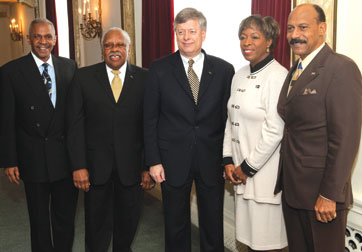 Gathered during the AACC luncheon were (from left) Robert Hill, Pitt’s vice chancellor for public affairs; John M. Wilds, assistant vice chancellor for community and governmental relations; Chancellor Nordenberg; Doris Carson Williams, AACC president; and Larry E. Davis, dean of Pitt’s School of Social Work. The luncheon was sponsored by PNC and H.J. Heinz Company.
Gathered during the AACC luncheon were (from left) Robert Hill, Pitt’s vice chancellor for public affairs; John M. Wilds, assistant vice chancellor for community and governmental relations; Chancellor Nordenberg; Doris Carson Williams, AACC president; and Larry E. Davis, dean of Pitt’s School of Social Work. The luncheon was sponsored by PNC and H.J. Heinz Company.University Overview
This region’s higher education sector is a rich one that contains many strong, and highly complementary, institutions. I need to underscore that fact from the outset because, given the position that I hold, I naturally will be focusing mainly on the institution that I represent, an institution that sits at the center of that sector, the University of Pittsburgh. And I am pleased to say that Pitt is an institution that really has been on the move:
• In terms of our most basic mission, we have nearly tripled applications for admission to the undergraduate programs in Oakland—going from less than 7,800 in 1995 to more than 22,000 this year. And our students, once enrolled, are performing at the very highest levels. This past year, to give just one highlight, we claimed our third Rhodes Scholar in the last five years. Since only 32 Rhodes Scholars are selected every year, from the very best students at the very best universities in the country, that really is an amazing record—more typical of an elite Ivy League institution than a public university in Pittsburgh;
• We now rank among the top 10 universities nationally in terms of total federal science and engineering research and development support and are fifth in the country in terms of faculty research support from the National Institutes of Health—joining Harvard, Johns Hopkins, Penn and UCSF in that distinguished grouping. Our research expenditures last year were more than $650 million. This year, we expect that they will significantly exceed $700 million. Those funds not only fuel important faculty work but support, directly and indirectly, some 23,000 local jobs; and
• We were the nation’s top-ranked public university in the 2009 edition of Saviors of Our Cities: A Survey of Best College and University Civic Partnerships—reflecting our deep commitments to the economic health and general vibrancy of this community.
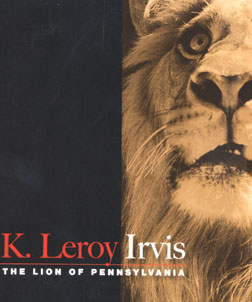 Pitt’s modern tradition of Black History Month celebrations began with the production and 2004 world premiere screening of the documentary K. Leroy Irvis: The Lion of Pennsylvania. Irvis, who in 1977 became the first African American speaker of the House in Pennsylvania and the first Black speaker of any state house since Reconstruction, sponsored in 1966 the bill that made Pitt a state-related institution of higher education, thus saving the University from economic ruin.
Pitt’s modern tradition of Black History Month celebrations began with the production and 2004 world premiere screening of the documentary K. Leroy Irvis: The Lion of Pennsylvania. Irvis, who in 1977 became the first African American speaker of the House in Pennsylvania and the first Black speaker of any state house since Reconstruction, sponsored in 1966 the bill that made Pitt a state-related institution of higher education, thus saving the University from economic ruin.Preserving Black History
And in terms of what many of us would consider to be a very significant contribution to the richness of this region, we have consciously played a major role in the preservation of Black history, in the presentation of African American culture, and in the constructive consideration of issues of race:
• We are the university that prepared and presented the provocative exhibition, Free At Last? Slavery in Pittsburgh in the 18th and 19th Centuries at the Heinz History Center;
• We are the university that has taken its Black History Month programs far beyond the customary speakers and panel discussions to research, present, and preserve such important aspects of this region’s Black history as the inspiring career of “the Speaker,” the Honorable K. Leroy Irvis; the bravery and patriotism of the Tuskegee Airmen from Western Pennsylvania; the trailblazing work of the Hill District’s Freedom House Ambulance Service; the enormous contributions—locally, nationally, and internationally—of The Pittsburgh Courier; and the Black experience, over two centuries, at the University of Pittsburgh itself;
• We are the university that has long been home to the Kuntu Repertory Theatre and the University of Pittsburgh Jazz Seminar and Conference; and
• We are the only American university to have a center on race and social problems in its School of Social Work. Dean and Center Director Larry Davis is here today, and I know that he would like to see many of you at his national conference on Race in America—a “blockbuster event” to be held in Oakland from June 3 to 6.
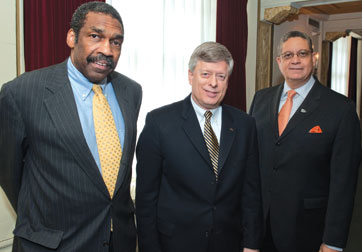 From left, William Strickland (A&S ’70), president and CEO of Manchester Bidwell Corporation and Pitt trustee; Chancellor Nordenberg; and Gregory R. Spencer (CGS ’80), president and CEO of Randall Industries, during the AACC luncheon.
From left, William Strickland (A&S ’70), president and CEO of Manchester Bidwell Corporation and Pitt trustee; Chancellor Nordenberg; and Gregory R. Spencer (CGS ’80), president and CEO of Randall Industries, during the AACC luncheon.The Regional Economy
Returning to commerce and the economy, Pitt sits at the heart of the education and health-services sector, which the U.S. Department of Labor has labeled the region’s largest employment “supersector.” To be absolutely clear, the people of this region benefit enormously from the continuing presence and impact of a strong, diverse, and committed corporate community. We see that very visibly today, with the generous sponsorships for this program that have been provided by PNC and Heinz. But in today’s attractively balanced regional economy, not only is the “eds and meds” sector the region’s single-biggest source of employment, but it is the only sector that has added jobs each and every year since 1995.
To focus on one recent period, from March of 2008 to March of 2009, this is what U.S. Department of Labor statistics show: The Pittsburgh area lost 7,400 manufacturing jobs; lost 5,300 leisure and hospitality jobs; lost 5,200 trade, transportation, and utility jobs; lost 2,600 professional and business services jobs; lost 1,700 construction jobs; lost 1,100 information and financial services jobs; and lost 1,600 government jobs. In sharp contrast, the only sector to gain at least 1,000 jobs in that same period was education and health services, which added 5,400 jobs.
Governmental Tensions
With that as context, you might ask—as I sometimes have asked myself—how did a nice guy like Mark Nordenberg, who leads such an important institution, come to spend most of the last year battling both the state Capitol and City Hall? Just in case any of you have forgotten, last summer, we suddenly confronted a Harrisburg declaration—in the face of decades of practice and precedent to the contrary—that Pitt, Penn State, and Temple were not “public.” Fortunately, that position was reversed in the U.S. Department of Education, but had it stuck, we would have been ineligible for stimulus funding. Our appropriation, then, was held hostage in legislative battles over gaming legislation. It was not approved until late December, nearly the midpoint of the fiscal year, and we received no state money until February. And we spent November and December very publicly battling the City’s proposed tuition tax.
Speaking generally, the answer to my rhetorical question is clear—elected officials, as a general matter, seem to be under increasing pressure to make decisions tied to a very short time span, and that general tendency is even more pronounced in economically challenging times. To be fair, the state does have a big budget hole to fill, and the City does have to meet the inherited problem of underfunded pension plans.
But in thinking about our shared longer-term interests, let me offer just a few thoughts:
• In a group like this one, I doubt that I need to persuade anyone that access to a higher education experience that is both affordable and of the highest quality sits at the very heart of the American dream. Pitt and Temple became state-related in the mid-1960s, thanks to the leadership of Speaker Irvis, when the Commonwealth recognized its responsibility to provide larger numbers of reasonably priced higher education opportunities to the first wave of baby boomers.
Today, what we see is a retreat from that social responsibility. I suspect that most of you, like me, either have been or will be able to provide your own children with a quality higher education. But we all will be disadvantaged if other people’s children get left behind. And that is the inevitable result when the Irvis legacy of support for public higher education is dismantled.
• Today, in addition to serving our fundamental educational mission, Pennsylvania’s public research universities provide so much more. At Pitt, we now annually import nearly $4 in research funding for every $1 of our state appropriation. In addition to the critical longer-term payoffs associated with both our educational and our research missions, then, we also provide a short-term return on investment through the attraction of job-generating research funds that probably cannot be equaled by any other state appropriation.
• There’s a recurring pattern that surfaces throughout government, and that presumably is the product of the pressures I mentioned earlier, to target the successful for short-term relief, whatever the long-term consequences might be. I say that, by the way, as an individual who believes in government and who does not mind paying his own taxes. But the avoidance of an uncompetitive business climate is a constant theme for organizations principally serving the for-profit community—something that presumably is true of the African American Chamber of Commerce.
The proposed tuition tax—among its many problems—would have created just that kind of uncompetitive environment for Pittsburgh’s higher education community—currently one of the main drivers of our regional economy. Any short-term gain, then, would have carried, as one price, longer-term disadvantages for our collective good.
When you hear someone talk about all of the property that is being “gobbled up” by the nonprofits and taken off the tax rolls, please ask for some examples, because very few exist. Even without data in front of you, just think about Pittsburgh’s landscape and ask yourselves why the City might have a higher percentage of tax-exempt property today than it did a dozen years ago.
Could it be because we now have a baseball stadium and a football stadium, rather than just one combined stadium? Could it be because we now have one hockey arena in use and another under construction? Could it be because we now have a beautiful, and very expansive, new convention center?
These are all great things, and I certainly am not complaining about them. Pitt, after all, plays football in one of those wonderful new stadiums. But this growth in the tax-exempt property rolls has been driven by very deliberate governmental decision-making. Whatever some might like you to believe, it has not been driven by unchecked “eds-and-meds” sprawl.
On the less positive side, the URA [Urban Redevelopment Authority] now holds title to a much larger collection of distressed properties. But whatever the reasons, good or bad, the simple fact is that while government has become the biggest complainer about tax-exempt properties, government, including its authorities, is, by far, the largest holder of tax-exempt properties.
Because many of you are familiar with our University, think for a moment about facilities development at Pitt over the course of the past decade or so:
• We tore down Pitt Stadium, which sat on already tax-exempt property in the middle of our campus, to build the Petersen Events Center, which has generated new amusement and parking tax revenue for the City;
• We built our new biomedical science tower, which has been a magnet for job-generating research dollars, on the worst, already tax-exempt, block of Oakland’s Fifth Avenue business corridor; and
• Our Sennott Square academic center, which generates local tax dollars through first-floor retail and a public parking garage, was built on the worst, already tax-exempt, block of the Forbes Avenue business corridor.
Big projects outside of our traditional footprint, most often undertaken with the UPMC as the lead partner, have been among the most significant regional development projects—clearly and significantly benefitting the greater good—of recent years:
• The McGowan Institute for Regenerative Medicine and UPMC Sports Performance Complex were built on the long-barren site of an old steel mill and became anchors for the entire South Works development, which may be this region’s best recent example of successful urban renewal;
• UPMC’s new Children’s Hospital, which includes a research tower occupied by Pitt faculty, was built on the abandoned campus of St. Francis Hospital, saving Lawrenceville from what might have been a “death blow”; and
• The Hillman Cancer Center—built by UPMC and half of which is occupied Pitt researchers—not only is a powerful economic engine in its own right but opened up new development possibilities along the Centre Avenue/Baum Boulevard corridor in the City’s East End.
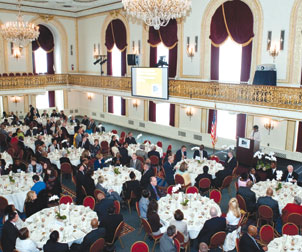 AAAC luncheon in the Omni William Penn Hotel, Downtown.
AAAC luncheon in the Omni William Penn Hotel, Downtown.Just a few days ago [in early May], Pittsburgh again was named this country’s most livable city. Everyone who lives here ought to be proud of that fact. And many of the people in this room have the right to smile even more broadly, because the contributions you have made—to the strength, health, and vitality of this community—have helped make this city so livable.
If we want to sustain our momentum through these challenging times, we really do need to work at it together—as many of us now are doing in trying to find a solution to the City’s pension problems. Put another way, we need to avoid the classic Pittsburgh practice of taking potshots and pointing fingers at each other. With respect to issues like these, we really are “in the same boat”—and we either are going to keep moving across the surface together “in synch” or struggle against each other and sink.
So, thank you—for having me here today, for being such good friends, and for being key partners in fueling Pittsburgh’s progress. Together, we do have the power to do wonderful things. And it always feels great to be moving forward in your distinguished company.
Other Stories From This Issue
On the Freedom Road

Follow a group of Pitt students on the Returning to the Roots of Civil Rights bus tour, a nine-day, 2,300-mile journey crisscrossing five states.
Day 1: The Awakening
Day 2: Deep Impressions
Day 3: Music, Montgomery, and More
Day 4: Looking Back, Looking Forward
Day 5: Learning to Remember
Day 6: The Mountaintop
Day 7: Slavery and Beyond
Day 8: Lessons to Bring Home
Day 9: Final Lessons

